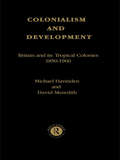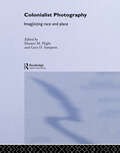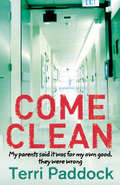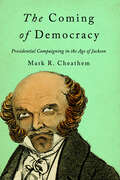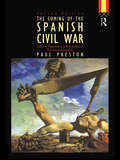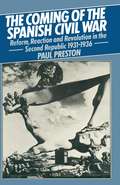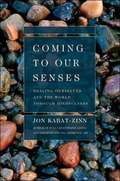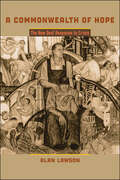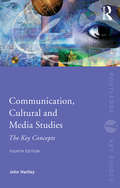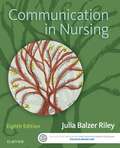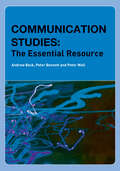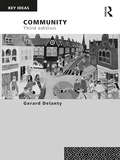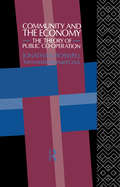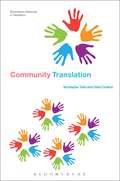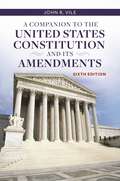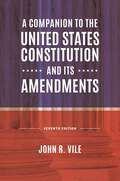- Table View
- List View
Colonialism and Development: Britain and its Tropical Colonies, 1850-1960
by Michael Havinden David MeredithBritish colonial rule of the tropics is the critical background to contemporary development issues. This study of Britain's economic and political relationship with its tropical colonies provides detailed analyses of trade and policy. The considerations of past successes and failures elucidate current opportunities and developments. No other book covers this broad topic with such detail and clarity.
Colonialist Photography: Imag(in)ing Race and Place
by Eleanor M. Hight Gary D. SampsonColonialist Photography is an absorbing collection of essays and photographs exploring the relationship between photography and European and American colonialism. The book is packed with well over a hundred captivating images, ranging from the first experiments with photography as a documentary medium up to the decolonization of many regions after World War II. Reinforcing a broad range of Western assumptions and prejudices, Eleanor M. Hight and Gary D. Sampson argue that such images often assisted in the construction of a colonial culture.
Come Clean
by Terri PaddockMesmerising, moving novel from an exceptional author about one girl’s struggle to cope after being wrongly admitted to a boot-camp-style rehabilitation centre. A powerful and page-turning read.
The Coming of Democracy: Presidential Campaigning in the Age of Jackson
by Mark R. CheathemAfter the "corrupt bargain" that awarded John Quincy Adams the presidency in 1825, American politics underwent a fundamental shift from deference to participation. This changing tide eventually propelled Andrew Jackson into the White House;¢;‚¬;€?twice. But the presidential race that best demonstrated the extent of the changes was that of Martin Van Buren and war hero William Henry Harrison in 1840. Harrison;€™s campaign was famously marked by sloganeering and spirited rallies. In The Coming of Democracy, Mark R. Cheathem examines the evolution of presidential campaigning from 1824 to 1840. Addressing the roots of early republic cultural politics;¢;‚¬;€?from campaign biographies to songs, political cartoons, and public correspondence between candidates and voters;¢;‚¬;€?Cheathem asks the reader to consider why such informal political expressions increased so dramatically during the Jacksonian period. What sounded and looked like mere entertainment, he argues, held important political meaning. The extraordinary voter participation rate;¢;‚¬;€?over 80 percent;¢;‚¬;€?in the 1840 presidential election indicated that both substantive issues and cultural politics drew Americans into the presidential selection process.Drawing on period newspapers, diaries, memoirs, and public and private correspondence, The Coming of Democracy is the first book-length treatment to reveal how presidents and presidential candidates used both old and new forms of cultural politics to woo voters and win elections in the Jacksonian era. This book will appeal to anyone interested in US politics, the Jacksonian/antebellum era, or the presidency.
The Coming of Democracy: Presidential Campaigning in the Age of Jackson
by Mark R. CheathemAfter the "corrupt bargain" that awarded John Quincy Adams the presidency in 1825, American politics underwent a fundamental shift from deference to participation. This changing tide eventually propelled Andrew Jackson into the White House;¢;‚¬;€?twice. But the presidential race that best demonstrated the extent of the changes was that of Martin Van Buren and war hero William Henry Harrison in 1840. Harrison;€™s campaign was famously marked by sloganeering and spirited rallies. In The Coming of Democracy, Mark R. Cheathem examines the evolution of presidential campaigning from 1824 to 1840. Addressing the roots of early republic cultural politics;¢;‚¬;€?from campaign biographies to songs, political cartoons, and public correspondence between candidates and voters;¢;‚¬;€?Cheathem asks the reader to consider why such informal political expressions increased so dramatically during the Jacksonian period. What sounded and looked like mere entertainment, he argues, held important political meaning. The extraordinary voter participation rate;¢;‚¬;€?over 80 percent;¢;‚¬;€?in the 1840 presidential election indicated that both substantive issues and cultural politics drew Americans into the presidential selection process.Drawing on period newspapers, diaries, memoirs, and public and private correspondence, The Coming of Democracy is the first book-length treatment to reveal how presidents and presidential candidates used both old and new forms of cultural politics to woo voters and win elections in the Jacksonian era. This book will appeal to anyone interested in US politics, the Jacksonian/antebellum era, or the presidency.
Coming of the Spanish Civil War: Reform, Reaction And Revolution In The Second Republic, 1931-1936
by Paul PrestonThis classic text is made newly available in a substantially revised and updated second edition.
The Coming of the Spanish Civil War: Reform, Reaction and Revolution in the Second Republic 1931–1936 (pdf)
by Paul PrestonComing to Our Senses: Healing Ourselves and the World Through Mindfulness
by Jon Kabat-ZinnCome to your senses with the definitive guide to living a meaningful life from a world expert in the connection between mindfulness and physical and spiritual wellbeing."[The] journey toward health and sanity is nothing less than an invitation to wake up to the fullness of our lives as if they actually mattered . . ." --Jon Kabat-Zinn, from the Introduction Jon Kabat-Zinn changed the way we thought about awareness in everyday life with his now-classic introduction to mindfulness, Wherever You Go, There You Are. Now, with Coming to Our Senses, he provides the definitive book for our time on the connection between mindfulness and our physical and spiritual wellbeing. With scientific rigor, poetic deftness, and compelling personal stories, Jon Kabat-Zinn examines the mysteries and marvels of our minds and bodies, describing simple, intuitive ways in which we can come to a deeper understanding, through our senses, of our beauty, our genius, and our life path in a complicated, fear-driven, and rapidly changing world. In each of the book's eight parts, Jon Kabat-Zinn explores another facet of the great adventure of healing ourselves -- and our world -- through mindful awareness, with a focus on the "sensescapes" of our lives and how a more intentional awareness of the senses, including the human mind itself, allows us to live more fully and more authentically. By "coming to our senses" -- both literally and metaphorically by opening to our innate connectedness with the world around us and within us -- we can become more compassionate, more embodied, more aware human beings, and in the process, contribute to the healing of the body politic as well as our own lives in ways both little and big.
Commerce and Capitalism in Chinese Societies
by Gary G. HamiltonThis informative book discusses the effects of the rise of Chinese capitalism on both China itself, and on its neighbours. Incorporating empirical data collated from interviews in several Asian societies and from historical Chinese sources, this renowned author analyzes, discusses and applies an institutional approach derived from the writings of Max Weber to explore the various aspects of Chinese economic practice. Consisting of sixteen articles that come together to provide historical, comparative and theoretically informed perspectives on the spread of Chinese capitalism, this collection emphasizes the difference between Western and Chinese forms of capitalism. Including sections on China's pre-industrial economy as well as the growth of modern Chinese capitalism, this collection will be a valuable resource for students of Asian and Chinese studies as well as those concerned with the economics of Chinese societies.
A Commonwealth of Hope: The New Deal Response to Crisis (The American Moment)
by Alan LawsonDid the New Deal represent the true American way or was it an aberration that would last only until the old order could reassert itself? This original and thoughtful study tells the story of the New Deal, explains its origins, and assesses its legacy. Alan Lawson explores how the circumstances of the Great Depression and the distinctive leadership of Franklin D. Roosevelt combined to bring about unprecedented economic and policy reform. Challenging conventional wisdom, he argues that the New Deal was not an improvised response to an unexpected crisis, but the realization of a unique opportunity to put into practice Roosevelt’s long-developed progressive thought. Lawson focuses on where the impetus and plans for the New Deal originated, how Roosevelt and those closest to him sought to fashion a cooperative commonwealth, and what happened when the impulse for collective unity was thwarted. He describes the impact of the Great Depression on the prevailing system and traces the fortunes of several major social sectors as the drive to create a cohesive plan for reconstruction unfolded. He continues the story of these main sectors through the last half of the 1930s and traces their legacy down to the present as crucial challenges to the New Deal have arisen. Drawing from a wide variety of scholarly texts, records of the Roosevelt administration, Depression-era newspapers and periodicals, and biographies and reflections of the New Dealers, Lawson offers a comprehensive conceptual base for a crucial aspect of American history.
A Commonwealth of Hope: The New Deal Response to Crisis (The American Moment)
by Alan LawsonDid the New Deal represent the true American way or was it an aberration that would last only until the old order could reassert itself? This original and thoughtful study tells the story of the New Deal, explains its origins, and assesses its legacy. Alan Lawson explores how the circumstances of the Great Depression and the distinctive leadership of Franklin D. Roosevelt combined to bring about unprecedented economic and policy reform. Challenging conventional wisdom, he argues that the New Deal was not an improvised response to an unexpected crisis, but the realization of a unique opportunity to put into practice Roosevelt’s long-developed progressive thought. Lawson focuses on where the impetus and plans for the New Deal originated, how Roosevelt and those closest to him sought to fashion a cooperative commonwealth, and what happened when the impulse for collective unity was thwarted. He describes the impact of the Great Depression on the prevailing system and traces the fortunes of several major social sectors as the drive to create a cohesive plan for reconstruction unfolded. He continues the story of these main sectors through the last half of the 1930s and traces their legacy down to the present as crucial challenges to the New Deal have arisen. Drawing from a wide variety of scholarly texts, records of the Roosevelt administration, Depression-era newspapers and periodicals, and biographies and reflections of the New Dealers, Lawson offers a comprehensive conceptual base for a crucial aspect of American history.
Communicating: The Multiple Modes of Human Communication
by Ruth FinneganMany accounts of human communication suggest that we are limited to communicating through words, visual images, the mass media and by digital means. This perspective underestimates the multisensory qualities of much of our human interconnecting and the multiple sounds, touches, sights and material objects which humans use so creatively to interconnect both nearby and across space and time. Ruth Finnegan brings together research from linguistic and sensory anthropology, alternative approaches to 'material culture' and 'the body', non-verbal communication, cultural studies, computer-mediated communication, and illuminating work on animal communication. Examples from both western and non-western cultures together with plentiful illustrations enrich and deepen the analysis. The book uncovers the amazing array of sounds, sights, smells, gestures, looks, movements, touches and material objects which humans use so creatively to interconnect both nearby and across space and time - resources consistently underestimated in those western ideologies that prioritise 'rationality' and referential language. Focussing on embodied and material processes, and on practice rather than text, this comparative analysis challenges the underlying cognitive and word-centred model common to many approaches to communication. The second edition of Communicating includes a new introduction, updates to take account of recent work, an additional chapter covering ethereal non-verbal non-bodily communicating such as telepathy and dreams, fresh illustrations, a new conclusion and updated bibliography. This authoritative but accessible book is an essential transdisciplinary overview for researchers and advanced students in language and communication, anthropology and cultural studies.
Communicating with Children and Adolescents: Action for Change
by Sue Jennings Anne Bannister Mario Cossa Kate Kirk Annie HuntingtonAt a time when expectations and assumptions about the delivery of services to children and adolescents are being reconfigured - for example, around the rights of children and adolescents as young citizens - adults are seeking to ensure that they deliver services in creative and empowering ways, ensuring that the opinions of young people are actively solicited and encouraged. Action methods - communication methods using the body as well as speech - provide non-threatening ways of communicating which can be understood by children of all ages and from many cultures. This book places action methods in a theoretical, technical and political framework and documents examples of good practice. Discussion of the application of action methods to work with young people focuses on differing issues and populations, for example children and adolescents who face life-threatening illnesses, or those involved in peer counselling in schools. Contributions from several different countries emphasise the wide potential of action methods for use with young people. This book provides a comprehensive and wide-ranging resource for those interested in exploring and understanding why action methods are particularly useful when working with young people.
Communication, Cultural and Media Studies: The Key Concepts (Routledge Key Guides)
by John HartleyThis fourth edition of Communication, Cultural and Media Studies: The Key Concepts is an indispensible guide to the most important terms in the field. It offers clear explanations of the key concepts, exploring their origins, what they’re used for and why they provoke discussion. The author provides a multi-disciplinary explanation and assessment of the key concepts, from ‘authorship’ to ‘censorship’; ‘creative industries’ to ‘network theory’; ‘complexity’ to ‘visual culture’. The new edition of this classic text includes: Over 200 entries including 50 new entries All entries revised, rewritten and updated Coverage of recent developments in the field Insight into interactive media and the knowledge-based economy A fully updated bibliography with 400 items and suggestions for further reading throughout the text
Communication in Nursing - E-Book: Communicating Assertively And Responsibly In Nursing
by Julia Balzer RileyImmerse yourself in the topic of communication in the workplace with an interesting conversation about the communication demands of today’s nursing practice! Communication in Nursing, 8th Edition adopts a uniquely practical and personal approach, providing extensive examples, exercises, and techniques that help you understand important concepts and apply communication skills in a variety of clinical settings. With its conversational tone, this relatable text takes you beyond theory to show you how to use communication as a tool to limit stress in your nursing practice. A new Active Learning feature that promotes goal-directed reading, and additional QSEN exercises highlight the importance of assertive communication in promoting quality, safe care for clients — all in an easy-to-read magazine layout.QSEN preface and exercises stress how communication impacts safety and quality of care.Moments of Connection boxes highlight beneficial outcomes of successful communication and provide concrete examples of how communication techniques work."Reflections on..." boxes provide thoughtful summary exercises at the end of each chapter that give you a specific task to help you integrate chapter material into the broader scope of nursing practice. Wit & Wisdom boxes present selected verses and quotations relevant to chapter topics, adding interest and humor. These boxes keep your attention by providing moments of relief from serious topics and "a-ha" moments when theory becomes linked to practice.Exercises throughout each chapter help you master chapter techniques and strengthen your communication skills.NEW! Active Learning feature in every chapter promotes active, goal-directed reading.NEW! Exercises in each chapter, including reflective journaling, remediation, online and group activities, and discussion topics, help facilitate various learning types.NEW and UPDATED! Additional QSEN exercises and an updated QSEN preface highlight the importance of assertive communication in promoting quality, safe care for clients.NEW! Discusses the importance of interprofessional education and communication in the healthcare environment. NEW! Addresses the importance of "presence" in nursing — being present for clients, families, colleagues, and self. NEW! New content on healthy grief and the issues of death denial and death phobia and professional boundaries related to social media.NEW! Coverage of the most current research about the importance of self-care. NEW! Explains the importance of the concept of "the pause" in communication so you better understand how and when to use pauses.
Communication in Nursing - E-Book: Communicating Assertively And Responsibly In Nursing
by Julia Balzer RileyImmerse yourself in the ideas, theories, and techniques of effective communication in the workplace! Communication in Nursing, 9th Edition adopts a uniquely practical and personal approach to the demands of today’s nursing practice, providing extensive examples, exercises, and techniques that help you to apply communication skills in a variety of clinical settings. Using a conversational tone, this relatable text takes you beyond theory to show you how to understand important concepts and use communication as a tool to limit stress in your nursing practice. The 9th edition includes a new chapter which focuses on the foundation of communication and personality assessment. It also includes a new Putting it into Practice feature to help you apply your new communication skills in the work environment. In addition, updates on the topics of mindfulness, resilience, and inter-collaborative communication highlight the importance of implementing these tools in practice. Active Learning features in every chapter promotes active, goal-directed reading.Wit & Wisdom boxes present selected verses and quotations relevant to chapter topics, adding interest and humor. These boxes provide moments of relief from serious topics and "a-ha" moments when theory becomes linked to practice.End-of-chapter exercises help you to master chapter techniques and strengthen your communication skills.QSEN preface and exercises stress how communication impacts safety and quality of care.Discusses the importance of interprofessional education and communication in the healthcare environment. Addresses the importance of "presence" in nursing — being present for clients, families, colleagues, and self.NEW! Starting with You chapter focuses on personality assessment using the Gallup CliftonStrengths among additional assessment methods. Two chapters have been combined to create a new one titled, Communicating Assertively and Responsibly with "Difficult" Clients and Colleagues, to help you better address aggressive and difficult clients and colleagues.UPDATED! Navigating the Expanding World of Digital Communication and Understanding Each Other chapters have been extensively updated to reflect most recent information. NEW! Chapter exercises incorporate teaching strategies such as cinemeducation and medical improvisation to help facilitate various learning types.UPDATED! Topics of mindfulness, resilience, and inter-collaborative communication have been incorporated throughout. NEW! Additional examples incorporated into Moments of Connection boxes highlight beneficial outcomes of successful communication and provide concrete examples of how communication techniques work.
Communication Studies: The Essential Resource
by Andrew Beck Peter Bennett Peter WallThis book brings together a huge range of material including academic articles, film scripts and interplanetary messages adrift on space probes with supporting commentary to clarify their imporatance to the field. Communication Studies: The Essential Resource is a collection of essays and texts for all those studying communication at university and pre-university level. Individual sections address: * texts and meanings in communication* themes in personal communication* communication practice* culture, communication and context* debates and controversies in communication.Edited by the same teachers and examiners who brought us AS Communication Studies: The Essential Introduction, this volume will help communications students to engage with the subject successfully. Its key features include: * suggested further activities at the end of each chapter* a glossary of key terms* a comprehensive bibliography with web resources.
Community: 3rd edition (Key Ideas)
by Gerard DelantyThe increasing atomization of modern society has been accompanied by an enduring nostalgia for the idea of community as a source of security and belonging in an increasingly insecure world. Far from disappearing, community has been revived by transnationalism and by new kinds of individualism. Gerard Delanty begins this stimulating critical introduction to the concept with an analysis of the origins of the idea of community in Western utopian thought, and as a theme in classical sociology and anthropology. He goes on to chart the resurgence of the idea within communitarian thought and postmodern philosophies, the complications and critiques of multiculturalism, and new manifestations of community within a society where changing modes of communication produce both fragmentation and possibilities of new social bonds. Contemporary community, he argues, is essentially a communication community based on belonging and sharing, and can be a powerful voice of political opposition. The communities of today are less spatially bounded than those of the past, but they cannot dispense with the need for a sense of belonging. The communicative ties and cultural structures of contemporary societies have opened up numerous possibilities for belonging based on religion, nationalism, ethnicity, lifestyle and gender.
Community: 3rd Edition (Key Ideas)
by Gerard DelantyThe increasing individualism of modern Western society has been accompanied by an enduring nostalgia for the idea of community as a source of security and belonging and, in recent years, as an alternative to the state as a basis for politics.Gerard Delanty begins this stimulating introduction to the concept with an analysis of the origins of the idea of community in Western Utopian thought, and as an imagined primitive state equated with traditional societies in classical sociology and anthropology. He goes on to chart the resurgence of the idea within communitarian thought, the complications and critiques of multiculturalism, and its new manifestations within a society where new modes of communication produce both fragmentation and the possibilities of new social bonds. Contemporary community, he argues, is essentially a communication community based on new kinds of belonging. No longer bounded by place, we are able to belong to multiple communities based on religion, nationalism, ethnicity, life-styles and gender.
Community and the Economy: The Theory of Public Co-operation
by Jonathan BoswellPresenting a new political and historical theory of the mixed economy, this book is a convincing argument for a challenging social ideal - democratic communitarianism. Individualistic notions of liberty, equality and prosperity are too central to modern life and they need to be balanced by values of `community' and co-operation. Arguing that such a transformation is possible and practical, the author argues that long-term changes must be achieved before economic success can take place in a more fraternal, participative, and democratic society.
Community Economic Development (Regions and Cities #Vol. 22)
by Graham HaughtonThis important book examines the ways in which community economic development can contribute to local and regional regeneration. It presents a unique overview of the state of contemporary British practice in this important policy area and provides a series of fresh, theoretical, methodological and empirical insights which help us to understand ways in which communities are facing up to the challenges of devising and bringing about their own revitalisation. Community Economic Development is underpinned by the argument that much conventional regeneration work represents at best a short-term fix rather than a long-term sustainable solution to the problems of socially excluded communities. The emphasis of the book is largely on the British experience with contributions from a rich mix of new and established academics and practitioners.
A Community of Individuals
by John LachsFirst published in 2003. Routledge is an imprint of Taylor & Francis, an informa company.
Community Translation (Bloomsbury Advances in Translation #2)
by Mustapha Taibi Uldis OzolinsInvestigating an important field within translation studies, Community Translation addresses the specific context, characteristics and needs of translation in and for communities. Traditional classifications in the fields of discourse and genre are of limited use to the field of translation studies, as they overlook the social functions of translation. Instead, this book argues for a classification that cuts across traditional lines, based on the social dimensions of translation and the relationships between text producers and audiences.Community Translation discusses the different types of texts produced by public authorities, services and individuals for communities that need to be translated into minority languages, and the socio-cultural issues that surround them. In this way, this book demonstrates the vital role that community translation plays in ensuring communication with all citizens and in the empowerment of minority language speakers by giving them access to information, enabling them to participate fully in society.
A Companion to the United States Constitution and Its Amendments
by John R. VileNow in its sixth edition with coverage of major Supreme Court decisions through the end of the 2013–2014 term, this book remains a key source for students, professors, and citizens seeking balanced, up-to-date information on the Constitution, its amendments, and how they have been interpreted.A document that is well past two centuries old, the U.S. Constitution remains as relevant and important today as during the time of our country's founding. Now in its sixth edition, this single-volume work offers a fair, non-partisan treatment of one of the most important documents in American history. The book begins with introductory background information on the U.S. Constitution and the Declaration of Independence and then presents a clause-by-clause explanation of the Constitution from the preamble through all of its amendments, addressing how each has been interpreted by the U.S. Supreme Court and other institutions throughout U.S. history. This fully updated edition of A Companion to the United States Constitution and Its Amendments incorporates numerous new developments in the four years since the previous edition, including the appointments of new Supreme Court justices, impactful cases involving First Amendment rights for students, the Affordable Care Act, National Security Agency (NSA) data gathering, voting rights, campaign finance law, DNA sampling, and the ongoing battle over gay rights. As with the previous editions, John R. Vile provides a balanced and thorough treatment that identifies key Supreme Court decisions and other interpretations of the document while abstaining from unnecessarily complex and confusing explanations.
A Companion to the United States Constitution and Its Amendments
by John R. VileThe U.S. Constitution and its 27 amendments (including the Bill of Rights) is a living document, as evidenced by new laws and Supreme Court rulings that with each passing year change how the Constitution's guidelines are interpreted and implemented.A Companion to the United States Constitution and Its Amendments is designed to show students just how revolutionary the Constitution was—and how relevant it remains today. This seventh revised edition of the Companion begins by revisiting the key events leading to the Constitution's ratification, including the writing of the Declaration of Independence and the proceedings of the Constitutional Convention, then explores the document article by article, amendment by amendment, to help readers better understand how each section of the document shapes the world we live in today.In addition, the Companion illuminates how new laws, political debates, and Supreme Court decisions are continually reshaping our understanding of the Constitution and its role in American life and society—including such essential and foundational elements of democracy as voting; elections; the peaceful transfer of power; equality before the law; civil rights and liberties; and the duties, responsibilities, and obligations of the nation's three branches of government.
